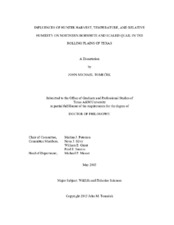| dc.contributor.advisor | Peterson, Markus J | |
| dc.creator | Tomecek, John Michael | |
| dc.date.accessioned | 2015-09-21T17:01:54Z | |
| dc.date.available | 2017-05-01T05:35:41Z | |
| dc.date.created | 2015-05 | |
| dc.date.issued | 2015-04-30 | |
| dc.date.submitted | May 2015 | |
| dc.identifier.uri | https://hdl.handle.net/1969.1/155149 | |
| dc.description.abstract | The northern bobwhite (Colinus virginianus) has declined in abundance and range across much of its historic range. Although most biologists attribute this decline to habitat loss and change, many stakeholders perceive that hunting is partially responsible. I designed 3 studies to investigate the potential influence of both environmental factors and hunting in the Rolling Plains of Texas: (1) I examined the relationship of bobwhite abundance, and hunter effort to determine which of these best explains total harvest at statewide and regional scales; (2) I constructed a simulation model to examine the differences between heterogeneously and homogeneously applied bobwhite harvest to determine if traditional, homogeneous estimates of sustainable harvest overestimate sustainable harvest rates; and (3) I tested the hypothesis that native bunch grass vegetation apparently suitable for bobwhite nesting can act as thermal refugia for bobwhites to avoid harmful heat stress.
First, I determined which factors that influence total bobwhite harvest differed across Texas, but in the Rolling Plains both the abundance of bobwhites as well as the number of days hunters spend afield most strongly explained harvest. Because a measure of hunter effort factored so strongly, it was unlikely that current regulations could limit bobwhite harvest at small enough scales to prevent localized overharvest. In turn, such overharvest could lead to broad scale declines in bobwhite abundance and range, or accelerate ongoing declines. Second, I determined which harvest trends resulted in lower landscape-level bobwhite density and range than under homogeneously applied harvest. Because harvest in the real world is applied heterogeneously and previously published sustainable harvest estimates relied on the assumption of homogeneously applied harvest pressure, it is likely that hunt managers harvest a larger proportion of the bobwhites on their property than they estimate. Finally, the ability to ameliorate heat stress was strongest during the late summer, when such nesting structures are at the peak of their growth cycle. Ultimately, range condition was strongly associated with both the magnitude of the temperature reduction and the duration of non-harmful temperatures. Thus, careful management of harvest and habitat are essential to maintain viable bobwhite subpopulations. | en |
| dc.format.mimetype | application/pdf | |
| dc.language.iso | en | |
| dc.subject | Bobwhites | en |
| dc.subject | Scaled Quail | en |
| dc.subject | Thermal Ecology | en |
| dc.subject | Harvest Theory | en |
| dc.subject | Spatially Explicit Modeling | en |
| dc.title | Influences of Hunter Harvest, Temperature, and Relative Humidity on Northern Bobwhite and Scaled Quail in the Rolling Plains of Texas | en |
| dc.type | Thesis | en |
| thesis.degree.department | Wildlife and Fisheries Sciences | en |
| thesis.degree.discipline | Wildlife and Fisheries Sciences | en |
| thesis.degree.grantor | Texas A & M University | en |
| thesis.degree.name | Doctor of Philosophy | en |
| thesis.degree.level | Doctoral | en |
| dc.contributor.committeeMember | Silvy, Nova J | |
| dc.contributor.committeeMember | Grant, William E | |
| dc.contributor.committeeMember | Smeins, Fred E | |
| dc.type.material | text | en |
| dc.date.updated | 2015-09-21T17:01:54Z | |
| local.embargo.terms | 2017-05-01 | |
| local.etdauthor.orcid | 0000-0002-7494-283X | |


